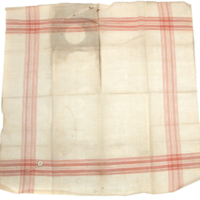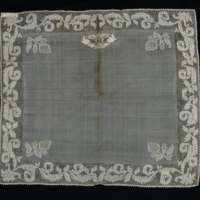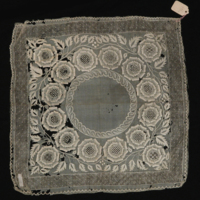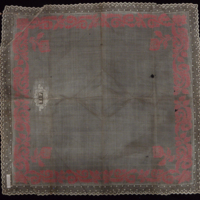Handkerchief
Text
Logbook of items:
Handkerchief from piña fiber
Original map/file:
Handkerchief from piña fiber or cotton
[added later:]
beige with red edge
Share this
Media
Images
Map Ethnographic Museum at the University of Zurich (Völkerkundemuseum der Universität Zürich)
Metadata
Rights
© Ethnographic Museum of the University of Zurich, photo: Silvia Luckner
Identifier
00605
Origin
Manila
Provenance
Gift from Emil Sprüngli.
He entered the silk company of his uncle, G. Thomann-Bolleter as a young man. After his apprenticeship, he moved to Manila where he worked for the trading house Lutz & Cie. He later opened his own company. For 37 years, he moved between Zurich and Manila, living intermittently in both places. From 1888 to 1910, he acted as honorary consul for Switzerland in the Philippines.
He entered the silk company of his uncle, G. Thomann-Bolleter as a young man. After his apprenticeship, he moved to Manila where he worked for the trading house Lutz & Cie. He later opened his own company. For 37 years, he moved between Zurich and Manila, living intermittently in both places. From 1888 to 1910, he acted as honorary consul for Switzerland in the Philippines.
Acquisition Date
1889
Display status
Not on display
Acknowledgements
Contributed by Dr. Andreas Isler of University of Zurich / Ethnographic Museum and studiyo-filipino.ch, Translated from German by Lenny Bugayong, Photo and Information University of Zurich / Ethnographic Museum
Official Website
Collection
Cite this Page
“Handkerchief,” Mapping Philippine Material Culture, accessed April 25, 2024, https://philippinestudies.uk/mapping/items/show/29298.
Geolocation
Sensitive Content
Mapping Philippine Material Culture collates digital material from institutions, and some of this material is inherently colonial and contains words, terms and phrases that are inaccurate, derogatory and harmful towards Filipino and Filipino diasporic communities. Catalogue transcriptions, book titles, exhibition titles and museum titles may contain harmful terms. We recognise the potential for the material to cause physical and mental distress as well as evoke strong emotions. Owing to the scale of the collection’s data, a process to implement sensitive-content warnings in the displayed data is still incomplete. The material within the catalogue does not represent Mapping Philippine Material Culture’s views. Mapping Philippine Material Culture maintains a strong anti-colonial, anti-racist position and affirms its support for centring the humanity of historically marginalised and disenfranchised communities.
Facebook Twitter



